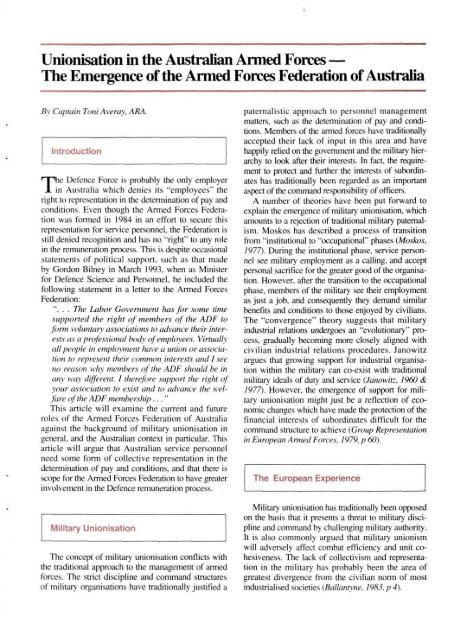ISSUE 107 : Jul/Aug - 1994 - Australian Defence Force Journal
ISSUE 107 : Jul/Aug - 1994 - Australian Defence Force Journal
ISSUE 107 : Jul/Aug - 1994 - Australian Defence Force Journal
Create successful ePaper yourself
Turn your PDF publications into a flip-book with our unique Google optimized e-Paper software.
.Unionisation in the <strong>Australian</strong> Armed <strong>Force</strong>s —The Emergence of the Armed <strong>Force</strong>s Federation of AustraliaBy Captain Toni Averay, ARA.Introducti onThe <strong>Defence</strong> <strong>Force</strong> is probably the only employerin Australia which denies its "employees" theright to representation in the determination of pay andconditions. Even though the Armed <strong>Force</strong>s Federationwas formed in 1984 in an effort to secure thisrepresentation for service personnel, the Federation isstill denied recognition and has no "right" to any rolein the remuneration process. This is despite occasionalstatements of political support, such as that madeby Gordon Bilney in March 1993, when as Ministerfor <strong>Defence</strong> Science and Personnel, he included thefollowing statement in a letter to the Armed <strong>Force</strong>sFederation:". . . The Labor Government has for some timesupported the right of members of the ADF toform voluntary associations to advance their interestsas a professional body of employees. Virtuallyall people in employment have a union or associationto represent their common interests and I seeno reason why members of the ADF should be inany way different. I therefore support the right ofyour association to exist and to advance the welfareof the ADF membership ..."This article will examine the current and futureroles of the Armed <strong>Force</strong>s Federation of Australiaagainst the background of military unionisation ingeneral, and the <strong>Australian</strong> context in particular. Thisarticle will argue that <strong>Australian</strong> service personnelneed some form of collective representation in thedetermination of pay and conditions, and that there isscope for the Armed <strong>Force</strong>s Federation to have greaterinvolvement in the <strong>Defence</strong> remuneration process.Military UnionisationThe concept of military unionisation conflicts withthe traditional approach to the management of armedforces. The strict discipline and command structuresof military organisations have traditionally justified apaternalistic approach to personnel managementmatters, such as the determination of pay and conditions.Members of the armed forces have traditionallyaccepted their lack of input in this area and havehappily relied on the government and the military hierarchyto look after their interests. In fact, the requirementto protect and further the interests of subordinateshas traditionally been regarded as an importantaspect of the command responsibility of officers.A number of theories have been put forward toexplain the emergence of military unionisation, whichamounts to a rejection of traditional military paternalism.Moskos has described a process of transitionfrom "institutional to "occupational" phases (Moskos,1977). During the institutional phase, service personnelsee military employment as a calling, and acceptpersonal sacrifice for the greater good of the organisation.However, after the transition to the occupationalphase, members of the military see their employmentas just a job. and consequently they demand similarbenefits and conditions to those enjoyed by civilians.The "convergence" theory suggests that militaryindustrial relations undergoes an "evolutionary" process,gradually becoming more closely aligned withcivilian industrial relations procedures. Janowitzargues that growing support for industrial organisationwithin the military can co-exist with traditionalmilitary ideals of duty and service (Janowitz, 1960 &1977). However, the emergence of support for militaryunionisation might just be a reflection of economicchanges which have made the protection of thefinancial interests of subordinates difficult for thecommand structure to achieve (Group Representationin European Armed <strong>Force</strong>s, 1979, p 60).The European ExperienceMilitary unionisation has traditionally been opposedon the basis that it presents a threat to military disciplineand command by challenging military authority.It is also commonly argued that military unionismwill adversely affect combat efficiency and unit cohesiveness.The lack of collectivism and representationin the military has probably been the area ofgreatest divergence from the civilian norm of mostindustrialised societies (Ballantyne, 1983, p 4).
















